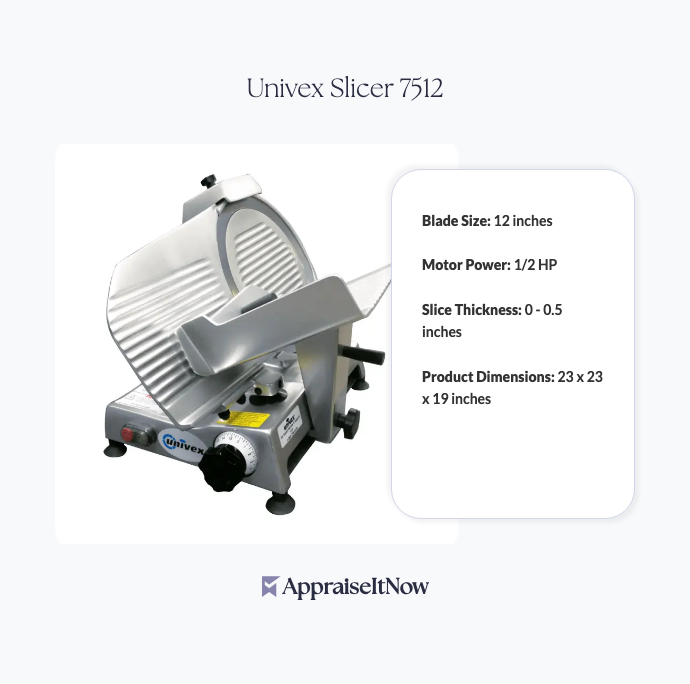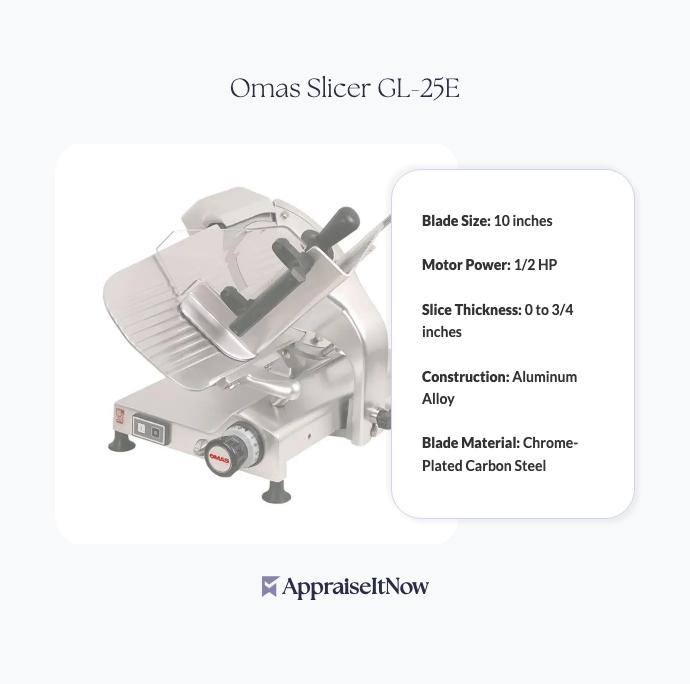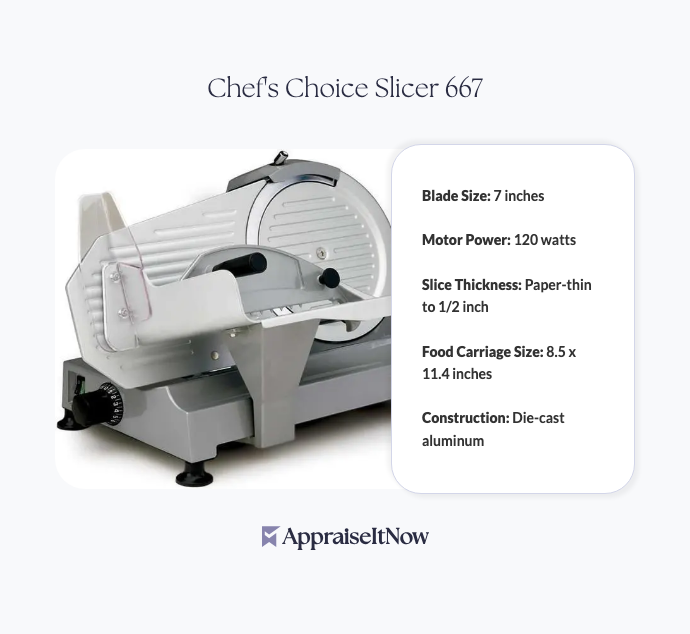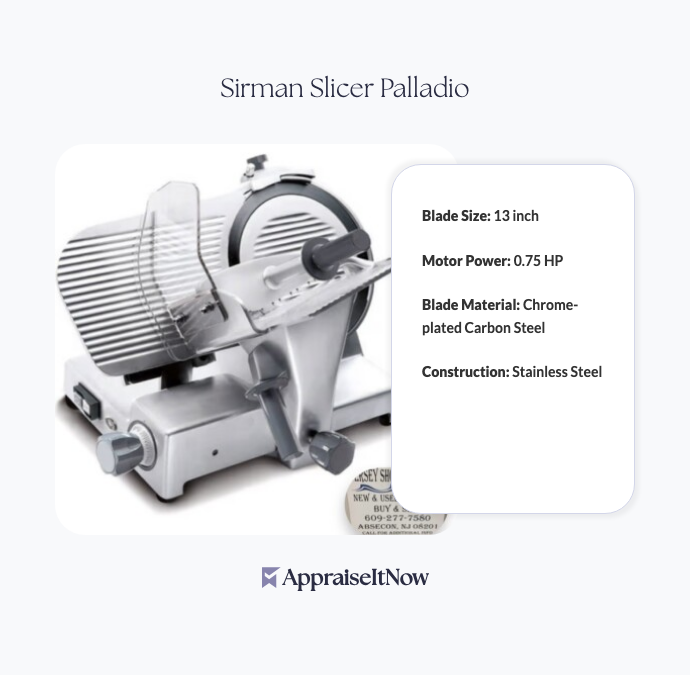<h1>How to Get Your Univex Slicer 7512 Appraised</h1>
<p>The Univex Slicer 7512 stands as a workhorse in professional foodservice environments, commanding respect from operators who depend on its precision, durability, and reliability. Whether you're evaluating this commercial-grade equipment for sale, insurance purposes, or business asset verification, understanding the appraisal process ensures you capture its true market value. Current market estimates place quality examples in the <strong>$4,000 to $6,000</strong> range, though individual valuations depend on several critical factors unique to your specific unit.</p>
<h2>Understanding Your Univex Slicer 7512's Market Position</h2>
<p>The Univex Slicer 7512 has been a staple in professional kitchens since its introduction in 1960, with approximately 500 units produced worldwide. This limited production run, combined with the equipment's proven track record across restaurants, catering operations, and institutional kitchens, creates genuine market demand among buyers seeking reliable used food processing equipment. Unlike many appliances that depreciate rapidly, commercial-grade slicers retain value through steady demand from operators replacing aged equipment or expanding production capacity.</p>
<p>Your specific Univex model represents a significant piece of <a href="/types/food-processing-equipment">food processing equipment</a> with commercial-grade durability built into its stainless steel construction. The precise slicing mechanism and intuitive speed controls remain functionally superior to many lower-tier alternatives today. When considering <a href="/blog/the-value-of-a-professional-restaurant-equipment-appraisal">restaurant equipment appraisal</a> services, understanding that this particular slicer delivers consistent slice thickness and superior portion control helps establish why buyers actively seek them out.</p>
<div class="callout tip"><p><strong>Market Insight</strong></p>
<p>Univex Slicer 7512 models with documented maintenance records often command 15-20% premiums over units with unclear service histories.</p></div>
<h2>Key Factors That Shape Your Appraisal Value</h2>
<p>Several interconnected factors directly influence whether your Univex Slicer 7512 appraises toward the lower or upper end of the $4,000-$6,000 range. Professional appraisers examine these elements systematically to deliver accurate valuations suitable for insurance, sale, or business asset documentation purposes.</p>
<h3>Age, Hours, and Operating Condition</h3>
<p>The age of your slicer matters less than its actual operating condition and documented usage history. Because your Univex was first introduced in 1960, many units operating today represent genuinely vintage equipment that collectors and operators value for their solid construction. What appraisers really investigate is whether the blade remains sharp and properly aligned, whether the motor operates smoothly without unusual vibrations, and whether the control mechanisms respond predictably.</p>
<p>Hours of operation tell a more complex story than simple age. A 20-year-old slicer that operated continuously in a high-volume deli will show different wear patterns than one that saw occasional use in a smaller establishment. Appraisers trained in <a href="/blog/the-basics-of-equipment-and-machinery-appraisal">equipment and machinery appraisal</a> understand that commercial equipment valuation requires assessing functional performance rather than assuming decline based on calendar age alone. Your unit's maintenance records become crucial documentation—they demonstrate whether previous operators invested in proper care, parts replacement, and professional servicing.</p>
<h3>Parts Availability and Obsolescence Markers</h3>
<p>As the Univex Slicer 7512 ages, parts sourcing becomes increasingly important to its practical value. Professional appraisers investigate whether essential components like blades, belts, and motors remain readily available through commercial suppliers or whether replacement parts have become scarce. A unit with easily sourced maintenance items appraises higher than one where critical components require specialized hunting or expensive fabrication.</p>
<p>Obsolescence typically doesn't dramatically impact the 7512's valuation because its mechanical design allows experienced technicians to fabricate or adapt replacement parts when necessary. However, if your specific unit shows corrosion, blade damage, or motor problems, replacement costs factor significantly into the appraiser's final determination. Clear photographs of any damage or wear points help appraisers assess restoration costs accurately.</p>
<h3>Documentation That Strengthens Your Appraisal</h3>
<p>Professional appraisers value comprehensive documentation because it validates both authenticity and operating history. For your Univex Slicer 7512, gather whatever records you can locate. The serial number itself provides crucial identification and allows appraisers to confirm production date and original specifications. Original purchase invoices, even if decades old, establish legitimate ownership and original equipment configuration.</p>
<p>Maintenance records demonstrating regular blade sharpening, motor servicing, and parts replacement significantly strengthen your appraisal. These documents prove the equipment received professional care rather than being run into the ground without attention. Operator manuals, service bulletins, or technical documentation also add credibility to valuations, particularly when seeking appraisals for <a href="/blog/streamlining-your-equipment-and-machinery-appraisal-process">equipment and machinery</a> used in regulated environments like food service.</p>
<h2>Navigating Different Appraisal Purposes and Value Types</h2>
<p>Your appraisal purpose fundamentally shapes how professional appraisers approach your Univex Slicer 7512 valuation. The same equipment might receive different valuations depending on whether you need fair market value, liquidation value, replacement cost, or loan collateral assessment.</p>
<p><strong>Fair market value</strong> represents what a willing buyer and willing seller would agree upon in an open marketplace transaction. This is the standard valuation type for general sales, insurance replacement documentation, and business asset verification. Your Univex at $4,000-$6,000 typically reflects fair market value across current used equipment markets.</p>
<p><strong>Liquidation value</strong> applies when you need rapid disposition of equipment during business closure or emergency cash requirements. Liquidation scenarios typically yield 30-50% lower valuations than fair market value. If your Univex Slicer 7512 needed quick liquidation, expect valuations in the $2,000-$3,000 range through auction channels or liquidators.</p>
<p><strong>Replacement cost</strong> matters for insurance purposes and represents what you'd pay to replace the functionality today. Modern commercial slicers comparable to your Univex's performance might cost $8,000-$12,000 new, but this doesn't inflate your used equipment's market value. Appraisers trained in <a href="/types/business-assets">business assets</a> valuation understand these distinctions clearly.</p>
<p><strong>Loan or collateral value</strong> typically ranges 50-70% of fair market value, reflecting lender conservatism in case repossession becomes necessary. Banks and equipment finance companies use these valuations to determine advance amounts on equipment-secured lending.</p>
<div class="callout note"><p><strong>Appraisal Purpose Matters</strong></p>
<p>Always specify your appraisal purpose clearly—lenders, insurers, and courts require precise designation to ensure the valuation serves your actual needs.</p></div>
<h2>Whether Remote Assessment or On-Site Inspection Makes Sense</h2>
<p>Professional appraisers commonly perform both remote photo-based assessments and on-site inspections for commercial deli slicers, with the approach depending on equipment condition clarity and appraiser experience. For a Univex Slicer 7512, determining whether remote or in-person inspection works best depends on several practical factors.</p>
<p>Remote photo-based appraisals work well when your Univex's condition is straightforward and readily apparent. High-quality photographs showing the equipment from multiple angles, including close-ups of the blade, motor condition, stainless steel finish, and control mechanisms, allow experienced appraisers to make reasonably confident valuations. This approach proves faster and less expensive, particularly valuable when you're seeking quick preliminary assessments before committing to full appraisals.</p>
<p>On-site inspections become essential when condition assessment requires hands-on evaluation or when your appraisal will support significant financial decisions. An in-person appraiser can operate your Univex Slicer 7512 directly, testing blade sharpness, motor responsiveness, safety controls, and overall mechanical function in ways photographs cannot capture. For equipment supporting insurance valuations, business asset documentation during acquisitions, or contested valuations, on-site inspection provides the evidentiary strength that courts, lenders, and major insurers require. When seeking comprehensive <a href="/blog/the-essential-guide-to-food-processing-equipment-appraisal">food processing equipment appraisal</a>, expect that significant valuations warrant professional site visits to validate condition and authenticity claims.</p>
<h2>Understanding Market Channels That Drive Realizable Value</h2>
<p>Your Univex Slicer 7512's achievable price depends partly on which buyer market you access. Different channels command different prices for identical equipment because buyer motivation, immediacy, and negotiating power vary significantly. Professional appraisers familiar with current market dynamics understand these channel differences and adjust valuations based on your intended sales path.</p>
<p><strong>Used restaurant equipment dealers</strong> represent the primary market channel for Univex slicers. These specialized businesses maintain established customer bases seeking reliable commercial equipment, and they typically pay 60-75% of fair market value when purchasing inventory. They accept this discount because retail markup covers their operational costs, warranty obligations, and customer acquisition expenses. If you're selling directly to a dealer for quick transaction completion, expect valuations toward the lower end of ranges.</p>
<p><strong>Restaurant supply auctions</strong> create competitive environments where multiple buyers bid for equipment. These auctions often achieve prices closer to true fair market value for quality Univex 7512 units because competitive bidding reflects genuine market demand. However, auction channels involve consignment fees (typically 10-25% of hammer price) that reduce your net proceeds.</p>
<p><strong>Online marketplaces</strong> like eBay, Craigslist, or specialized equipment sites allow direct buyer contact, potentially capturing premium prices if you connect with exactly the right operator seeking your specific model. Private sales through these channels frequently achieve the upper valuation ranges but require substantially more seller involvement and marketing effort.</p>
<div class="callout tip"><p><strong>Channel Strategy</strong></p>
<p>Your appraisal establishes fair market value, but where you ultimately sell determines realized value. Align your sales channel choice with your timeline and involvement capacity.</p></div>
<h2>Practical Timeline Expectations for Your Appraisal</h2>
<p>The time required for a professional Univex Slicer 7512 appraisal depends on several variables that impact turnaround timing. Understanding these factors helps you plan appropriately whether you need quick preliminary assessments or comprehensive documentation.</p>
<p><strong>Remote photo-based appraisals</strong> typically turnaround within 2-5 business days. You submit high-quality photographs and basic equipment information, and experienced appraisers deliver preliminary valuations relatively quickly. This approach works well for initial decision-making or preliminary negotiations.</p>
<p><strong>On-site inspections</strong> typically require 5-10 business days from scheduling through final report delivery. The appraiser schedules a site visit, conducts hands-on equipment assessment (often 30-60 minutes for a single slicer), documents findings with photographs and measurements, performs market research on comparable recent sales, and produces a detailed written report. Additional turnaround time may apply if the appraiser requires secondary research into specific serial numbers or specialized market analysis.</p>
<p><strong>Complex valuations</strong> involving multiple pieces of equipment, detailed historical research, or specialized market conditions may extend timelines to 2-3 weeks. Appraisers specializing in <a href="/blog/a-guide-to-navigating-restaurant-equipment-appraisals">restaurant and food service equipment</a> maintain databases of comparable recent transactions, allowing faster market analysis compared to generalist appraisers.</p>
<h2>Understanding Professional Appraisal Costs and Fee Structures</h2>
<p>Professional appraisal fees for a single Univex Slicer 7512 typically range from <strong>$300-$600</strong> for USPAP-compliant reports, though several factors drive variation within this range. Understanding what influences pricing helps you budget appropriately and evaluate fee reasonableness from different appraisers.</p>
<p><strong>Appraiser credentials significantly impact fees.</strong> Specialists holding certifications from organizations like <strong>AAA (American Association of Appraisers)</strong>, <strong>ISA (International Society of Appraisers)</strong>, <strong>ASA (American Society of Appraisers)</strong>, or <strong>CAGA (Canadian Association of Personal Property Appraisers)</strong> typically charge higher fees than generalist appraisers because their specialized expertise reflects substantial professional investment. However, this credential investment typically delivers more defensible, accurate valuations that courts and financial institutions accept without question.</p>
<p><strong>Appraisal scope and report detail</strong> drive fee variation. A brief letter opinion valuing your Univex Slicer 7512 might cost $300-$400, while a comprehensive USPAP-compliant narrative report including detailed condition assessment, market research documentation, and comparable sales analysis could reach $500-$600. If you require your appraisal for insurance, lending, or litigation purposes, investing in comprehensive documentation prevents challenges down the road.</p>
<p><strong>On-site travel expenses</strong> add to fees when appraisers must travel to your equipment location. Remote photo-based appraisals eliminate this cost factor, while on-site inspections typically add $100-$250 depending on travel distance and local market rates.</p>
<p><strong>Multi-item inventory appraisals</strong> often provide better per-unit economics than single-item valuations. If you're appraising multiple pieces of <a href="/types/equipment-and-machinery">equipment and machinery</a> simultaneously, appraisers typically offer volume discounts because they consolidate travel and research efficiency.</p>
<p>AppraiseItNow connects you with credentialed appraisers offering transparent fee structures before beginning work, ensuring you understand costs upfront.</p>
<h2>Documentation Formats That Lenders, Insurers, and Courts Accept</h2>
<p>Professional appraisers produce specific report formats designed for different stakeholder requirements. Understanding these distinctions helps you request appropriate documentation matching your intended use.</p>
<p><strong>USPAP-compliant reports</strong> represent the gold standard for financial and legal purposes. These detailed documents must conform to the <strong>Uniform Standards of Professional Appraisal Practice</strong>, meeting rigorous requirements for appraiser credentialing, work file documentation, and valuation methodology disclosure. Courts, lenders, and major insurers require USPAP compliance for valuations supporting significant financial decisions. Your Univex Slicer 7512 appraisal for mortgage lending, litigation, or estate purposes should specify USPAP compliance explicitly.</p>
<p><strong>Signed professional certifications</strong> accompany most formal appraisals, representing the appraiser's sworn statement that their opinions are based on professional analysis. This certification language carries particular weight in court proceedings or when insurers challenge valuations.</p>
<p><strong>Narrative reports</strong> provide detailed written analysis including equipment description, condition assessment, comparable sales documentation, market analysis, and explicit valuation conclusions. These comprehensive reports work best for significant valuations, contested situations, or when detailed explanation serves your purposes. Narrative reports typically cost more than summary valuations but provide substantially stronger evidentiary support.</p>
<p><strong>Photography and documentation</strong> standards vary but typically include multiple angles showing overall equipment condition, close-ups of identifying features and any damage or wear. Professional appraisers maintain detailed work files documenting their investigative process.</p>
<div class="callout note"><p><strong>Report Selection Matters</strong></p>
<p>Match your appraisal report format to your intended use—casual sales might need only letter opinions, while insurance and lending require comprehensive USPAP-compliant documentation.</p></div>
<h2>Summary: Making Your Univex Slicer 7512 Appraisal Work</h2>
<p>Your Univex Slicer 7512 represents a valuable commercial asset worth $4,000-$6,000 in today's market, but realizing that value requires clear understanding of your specific equipment's condition, documented history, and your appraisal purpose. Professional appraisals deliver the credible, defensible valuations that support confident buying, selling, or insurance decisions while meeting the rigorous standards that lenders, courts, and financial institutions demand.</p>
<p>Whether you're selling equipment, establishing insurance coverage, pursuing business financing, or navigating estate distribution, engaging a credentialed appraiser familiar with commercial food processing equipment ensures accurate valuation and proper documentation. AppraiseItNow connects you with certified specialists across the U.S. who provide USPAP-compliant appraisals tailored to your specific needs and timeline requirements, ensuring your valuable commercial slicer receives the professional evaluation it deserves.</p>







.avif)







